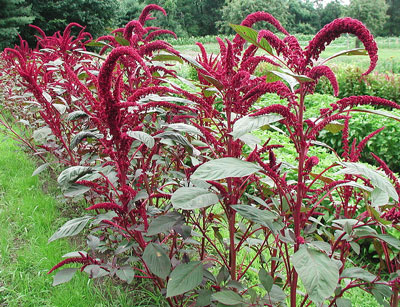Amaranthus – A Hunter Who the Goddess Artemis Revived as a Flower
Scientific Classification
| Kingdom: | Plantae |
| (unranked): | Angiosperms |
| (unranked): | Eudicots |
| (unranked): | Core Eudicots |
| Order: | Caryophyllales |
| Family: | Amaranthaceae |
| Subfamily: | Amaranthoideae |
| Genus: | Amaranthus L |
Amaranthus generally goes under the name of amaranth and belongs to the Dicot Family Amaranthaceae. It is a perennial plant with a short life. Catkin-like-cymes (a slim cylindrical arrangement of a flower cluster in a plant inflorescence) of thickly crammed flowers bloomed in autumn or winter. They have identified 60 varieties with leaves and inflorescence with colors changing from red and purple to gold or green. The Amaranthus group of plants has several similarities and uses similar to their associate type Celosia. Although some people consider these as weeds, they are more popular as cereals, leaf vegetables and as ornamental plants. The word “amaranth” derives from the Greek word (amarantos) meaning “unfading”. Greek mythology tells the tale of a hunter called Amaranthus who the Goddess Artemis revived as a flower after he died in a tidal wave triggered by Posidon whom he had angered.
Anatomy
This Amaranthus plant grows abundantly as weeds in several regions around the world to a height of 90 to 150 cm. All amaranth leaves form alternately on the stem that has a reddish color. Flowers are greenish and miniature in size in a thick bush form at the tip of the plant. In the weedy variety, the seeds are black to brown and in the household variety it is light-colored.
How to Cultivate Domestically
Preparation for Planting

Photo by: Dwight Sipler
Amaranth plants love sunlight and grow well in temperatures ranging from 70° to 80°F. Plant your Amaranthus somewhere in March or June based on where you live. In case you live on the Eastern coast, then plant your Amaranthus later than when you live in the northwestern area. However, the ideal months for planting this beautiful plant are April to May.
Planting
- Clear your planting area from the weeds, grass, brush and debris. Amaranthus challenges every other plant and when crammed they grow in miniature size.
- Use a rototiller and till the soil to a depth as much as the blade permits. Work with your tools when the soil is dry enough not to adhere to your garden tools and until the soil attains a fine texture.
- Form rows in the soil of ½ inch depth with the edge of your garden hoe. Place the rows 30 inches apart. Distribute Amaranthus seeds 5 to 6 inches apart in the rows. If you exceed sowing there is no harm, when the plants attain 6 inches height separate the seedlings.
- Place loose soil on the seeds and do not ram them down, because the crust of any variety of soil can jam the seeds. In amaranth the facile germination of the seeds requires close attachment to the soil.
- Spray water on the area till you dampen the soil. Do not water in excess so that does not accumulate and seeds get washed away.
Placement and Watering
Amaranth plants flourish in moderately rich and properly drained soil with reasonable availability of phosphorus and nitrogen. For best results Amaranthus requires at least minimum five hours sunshine in a day in the same way that other vegetable crops do. They favor a properly drained soil and moderate climate. In sultry climate, water the Amaranthus one or two times a week.
Flowering Period
In case you plant your Amaranthus many days early, it initiates flowering, following which it has amassed enough heat units and growth. In case you plant them later, the photoperiod (length of the day) affects the flowering.
After-Bloom Care
Amaranth continues flowering until its affectation by the first severe frost. Many weeks before the frost, the seeds ripen (normally around three months). The ideal method of identifying whether the seeds are ready to reap is by rubbing the heads of the flowers tenderly, but vigorously, amidst your palms and see whether the seeds drop easily.
As Cut Flowers

Photo by: Dwight Sipler
Amaranthus contributes greatly to decorations as they can sustain for a longer period as cut flowers when you apply bleach on them. The bleach assists in killing the germs that grow in the water where you keep the cut flowers, and makes the water appear crystal clear when you add plant food.

Having discovered a fondness for insects while pursuing her degree in Biology, Randi Jones was quite bugged to know that people usually dismissed these little creatures as “creepy-crawlies”.







